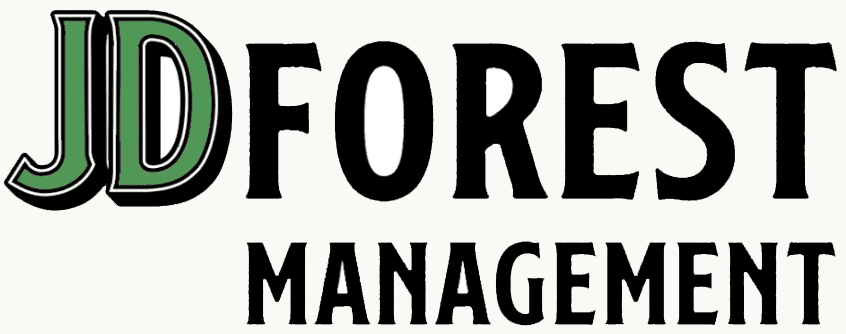Burn Reforestation & Tree Planting
Create a burn reforestation plan, secure funding and get the tree planting done!

Forester Site Visit & Planning
The aftermath of a burn can be overwhelming, with so many things to do. A good first step is calling a consulting forester for a free site visit to get professional guidance on how to get your property cleaned up. Professional consulting foresters have seen dozens of burns before and can provide valuable advice on cleanup of dead trees, salvage logging, erosion control, grant funding opportunities for reforestation, and solutions to other common post-burn problems.
After the free initial site visit a forester can create a full cleanup and reforestation plan for your property. This plan is comprehensive starting with the cleanup of dead trees and debris going all the way through to tree planting in 6 to 18 months.
The plan will also include quotes for each of the services and the grant funding opportunities available. Depending on your situation, grant funding opportunities may cover between 66% to 100% of the project costs.
Your customized burn reforestation plan will include strategies for cleanup of dead trees, site preparation for planting, seedling selection (considering species, seed source, and elevation), seedling purchasing, tree planting labor, and ongoing post-planting monitoring and management.
Local forester resources:
- Eastern WA – Jake Weimer, Jake@jdforestmanagement.com
- North Idaho – Brynne Johnson, Brynne@jdforestmanagement.com
- WSU Extension Forester Directory
- Other Regions – Society of American Foresters Directory

Grant Funding
Sourcing reforestation funding is usually the largest project hurdle for burn reforestation. Staying on top of application deadlines, paperwork and particular funding criteria is important to ensure your application is successfully funded. A consulting forester can help you get the funding applications submitted on time as well as ensure your project is well-represented for the best chance of funding.
There are many good sources of grant funding for burn reforestation available right now. For eastern Washington burns the Washington DNR has grant funding for projects meeting specific criteria. Federal NRCS EQIP funding opportunities are available to landowners in either eastern Washington or north Idaho. In some cases private grant funding is available either through carbon sequestration offsets or other funding pools. A forester will be able to guide you through what funding opportunity makes the most sense for your particular situation.
Reforestation costs range from $600-$900/acre depending on the type of site prep used, planting spacing (trees per acre), and other factors. Depending on the number of acres needing reforestation this can be a very substantial expense!
Funding resources:
- Washington DNR
- NRCS EQIP
- Eastern WA – Jake Weimer, Jake@jdforestmanagement.com
- North Idaho – Brynne Johnson, Brynne@jdforestmanagement.com
- WSU Extension Forester Directory
- Other Regions – Society of American Foresters Directory
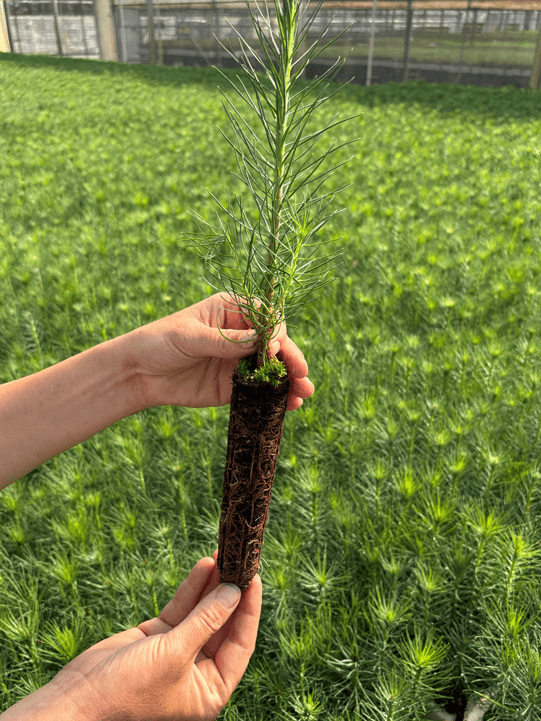
Securing Seedling Supply
Once the reforestation plan has been made and grant funding has been secured it is time to execute on completing the work.
Confirming that seedlings of the appropriate species, elevation and seed source are available is crucial prior to scheduling site preparation or tree planting operations. There are many seedling suppliers in eastern Washington and north Idaho that grow seedlings in anticipation of planting demand from burns. However, seedling growing is an 18-month process, so it is always wise to double check that seedlings are not yet “sold out” prior to scheduling work on your property.
Seed source and species selection are technical forestry considerations, so it makes sense to have your consulting forester guide you through the process and ensure the selected seedlings are appropriate for your property. For example, if your property is in the valley at 2,200’ and was primarily ponderosa pine then using a western larch seed source from 4,000’ would not be acceptable.
In many cases improved seed is available for planting. This seed is collected from parent trees with the best genetics across the region rather than woods-run seed from just one site. Foresters often prefer improved seed for seedlings that have the fastest growth or the best disease resistance.
Local seedling suppliers:
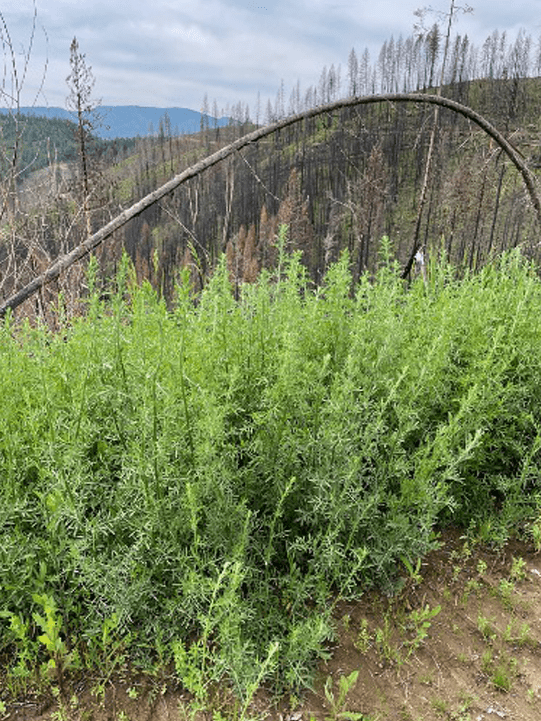
Site Preparation
After confirmation of seedling supply availability it is time to prepare the site for planting. Depending on the type of site preparation outlined in the reforestation plan this may occur in the fall prior to spring tree planting, 1 week prior to spring planting, or at the same time as planting.
Good site preparation for tree planting is critical and often makes the difference in achieving planting success. Burnt properties tend to be in dry areas with hot summers where water is the limiting factor to growth. Ensuring adequate control of competing vegetation is critical so that fast-growing noxious weeds do not outcompete planted seedlings for the water needed to survive and grow.
Site preparation can be done mechanically or by applying herbicides targeting invasive weeds. In many cases landowners prefer spot sprays creating weed-free plant-able circles for seedlings. In other cases landowners may elect to treat noxious weeds on the entire property using selective herbicides that target common weed species such as thistle, prickly lettuce and knapweed (shown in photo). Mechanical site preparation such as salvage logging or mastication can also work for short-term vegetation control in specific situations.
Resources:
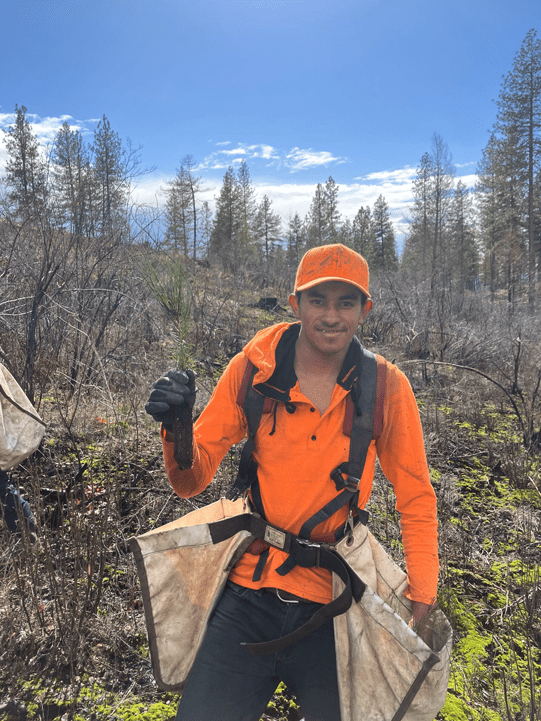
Tree Planting
Securing contract tree planting labor for the seedlings is critical to ensure seedlings can get planted in the appropriate spring seasonal window. In low-elevation sites throughout the Inland Northwest this usually means the last week of March through the first week of May, depending on the elevation of the property.
If your property is small (<10 acres needing 3,000 trees or less) it makes sense to partner with neighbors to reach a tree quantity that is economical for a full 12-man contract crew. A crew can plant between 16,000 to 20,000 seedlings in a day. Your consulting forester may have other nearby clients and be able to package several projects together to reach economies of scale.
Make sure that you have a consulting forester tree planting inspector lined up for the day of planting to ensure good planting quality. Most crews are paid by the tree, so it is important to have a forester tree planting inspector on site. Common mistakes include planting trees too close and not being able to cover the whole unit, “J-rooting” seedlings, planting too shallow or too deep, or not “micro-siting” the seedling behind stumps or downed logs for partial shade.
Local tree planting contractor resources:
-
- Eastern WA – Jake Weimer, Jake@jdforestmanagement.com
- North Idaho – Brynne Johnson, Brynne@jdforestmanagement.com
- WSU Extension Silvicultural Contractor Directory
- Washington DNR Tree Planting Guide
- Idaho Dept. of Lands Tree Planting Guide
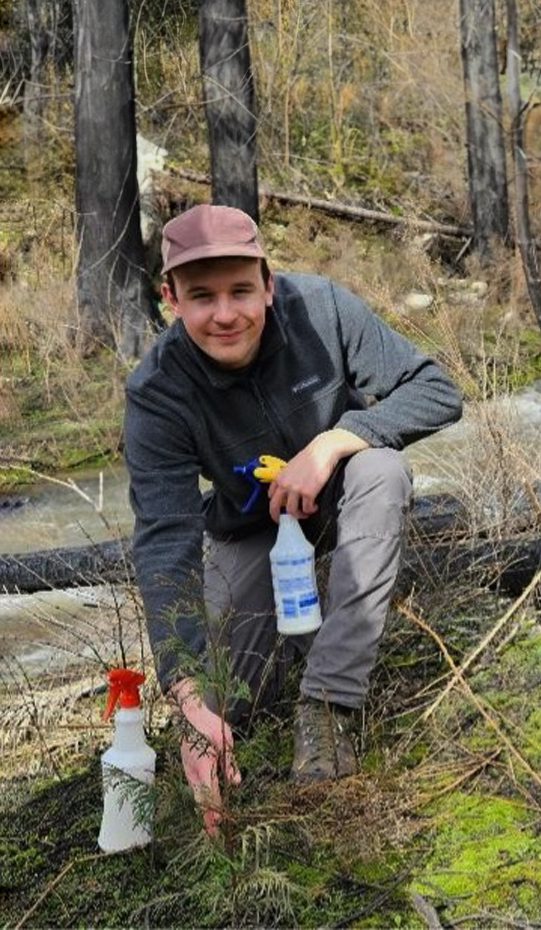
Post-planting Management
You now have the trees planted – great! However, the job is not over until the trees are “free to grow” or about 5 feet tall.
The first 2 years after planting are critical for monitoring to see if additional post-planting treatments are required. Think about these treatments as tending your newly planted forest garden – make sure and protect your trees from deer, weeds, and rodents. Your project consulting forester can help you monitor the site and make recommendations ahead of time – by the time you notice deer browse, gophers or a substantial weed problem it may be too late.
Browse Control: low-elevation valley sites tend to have substantial browse from deer and elk in the winter. This is especially true on south- or west-facing aspects and ridgetops that have less snow in the winter. Bud capping is a common treatment where a piece of paper or plastic mesh is stapled around the tip or “bud” of the seedling. Deer repellent sprays such as Trico Pro (see photo of Trico on planted cedar) are also common. Vexar tree tubing is expensive but is used in situations with very high browse risk.
Weed Control: invasive weeds are a common problem in disturbed post-burn landscapes. Fortunately, there are many selective herbicides that are safe to seedlings but effective on common post-burn weeds such as knapweed, thistle and prickly lettuce.
Gophers: gophers can be a problem in the forest just the same as in a garden. There are several rodent control treatment methods available in a forestry setting.
Local consulting forester resources:
- Eastern WA – Jake Weimer, Jake@jdforestmanagement.com
- North Idaho – Brynne Johnson, Brynne@jdforestmanagement.com
- WSU Extension Forester Directory
- Other Regions – Society of American Foresters Directory
Why Choose JD Forest Management?
Hire a professional forester to manage your logging operation
Our professional foresters have 4-year degrees providing a technical background in forest diseases, silviculture (the science of growing trees), logging operations, reforestation, and much more. A timber harvest may happen on a property only once every 15-20 years so make sure you use a trusted professional to get it done right! Our timber capital management techniques help you maximize returns
on your timber.
Over 40 Years of experience
We have been managing private forestlands in northern Idaho, eastern Washington, and northwestern Montana for over 40 years. Including Boundary County, Bonner County, Kootenai County, Benewah County, Shoshone County, Latah County, Clearwater County, Idaho County, Stevens County, Pend Oreille County, Spokane County, Lincoln County, and Sanders County.
Insurance and Contracts
We use strong legal contracts drafted by attorneys for all forestry contract work. This protects the landowner from liability and makes the work specifications clear to all parties. We are insured and make sure all contractors provide proof of insurance as well.
We manage 20,000+ acres of timberland at present
No project is too big and we definitely have the capability to help you manage your forest no matter if it’s 10 acres or 1,000 acres!
What Now?
Schedule a site visit with a forester to discuss your goals and objectives for your property. After the site visit, we will outline the steps required to reach your goals and provide pricing for each service. Feel free to learn more about our process or schedule a site visit today.
Call Today
(208)-817-9786
Email Us
info@jdforest.com
Resources
Click To Learn More
